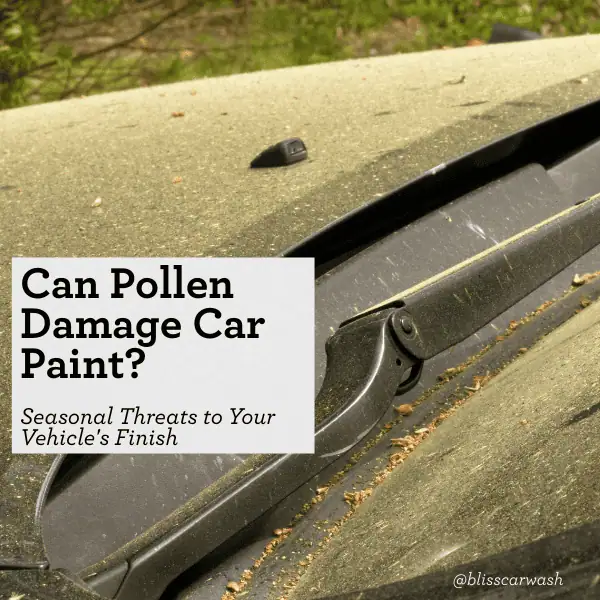If you’ve ever parked under a tree in spring and returned to find your car dusted in yellow, you’ve probably asked yourself can pollen damage car paint—and the short answer is, yes, if you’re not careful. While it may seem harmless, that fine layer of dust can lead to serious issues for your vehicle’s finish when combined with moisture, heat, and time. And pollen is just the beginning.
From acidic rain to sticky sap and bird droppings, your car faces a seasonal assault on its shine. In this article, we’ll break down how pollen affects your car’s paint—and how to protect it.
Understanding Pollen and Its Characteristics
Pollen is a fine powder produced by plants as part of their reproductive process. Trees, grasses, flowers, and weeds release billions of tiny pollen grains into the air, often carried by wind, insects, or animals. While it’s essential for plant life, it’s a nuisance for allergy sufferers—and car owners.
Pollen season typically ramps up in spring, with a second wave in late summer and early fall, depending on the region. In areas with high vegetation or warm climates like Southern California, pollen can coat vehicles almost daily during peak months.
Under a microscope, pollen isn’t soft or smooth. It often has a spiky, textured surface, designed to cling to insects or other pollinators. That same rough surface makes it mildly abrasive—especially when wiped off dry. Add in its acidity when wet, and pollen becomes more than just an annoyance—it becomes a real threat to your vehicle’s paint.
How Pollen Interacts with Car Paint
At first glance, pollen might look like a light dusting—harmless, even. But the way it interacts with your car’s surface can tell a very different story. Depending on whether it’s dry or wet, pollen can pose a real threat to your vehicle’s finish.
Dry Pollen
When pollen is dry, it doesn’t immediately damage your paint. But trouble starts when you try to wipe it off. Because of its microscopic, jagged surface, dry pollen can act like sandpaper. If you use a dry cloth or brush it away with your hand, you risk creating micro-scratches in the clear coat. These small abrasions may not be visible at first but can dull the paint over time, especially under sunlight.
Wet Pollen
When pollen gets wet—from dew, rain, or even humidity—it becomes far more corrosive. Moisture activates the natural acids within pollen, turning it into a mild acidic film. If left to sit, this mixture can etch into the clear coat, breaking down the protective barrier and exposing the base layer of paint.
Prolonged exposure to wet pollen also accelerates oxidation, which leads to fading, chalking, and long-term damage that can only be corrected with polishing—or repainting.
Preventive Measures to Protect Your Vehicle’s Finish
The best way to fight pollen and seasonal contaminants is to stay one step ahead. A few simple habits can go a long way in preserving your vehicle’s shine and protecting your paint.
Regular Washing
During peak pollen seasons—especially spring—frequent washing is a must. Allowing pollen to build up increases the chance of etching and stains, particularly when it gets wet. Aim to wash your car every few days, or weekly at minimum.
Use a pH-balanced car shampoo, soft microfiber mitts, and plenty of water to rinse first before making contact. This prevents scratching from dry pollen or dust acting like sandpaper.
Protective Coatings
Layering your car with protection helps create a strong barrier.
- Carnauba wax provides water resistance and short-term defense.
- Paint sealants offer longer-lasting protection from contaminants.
- Ceramic coatings form a hydrophobic, durable shield that resists pollen, sap, bird droppings, and more.
Proper Parking
Whenever possible, avoid parking under trees or near pollen-heavy areas. Covered garages or shaded spots with low exposure to vegetation are ideal.
Use of Car Covers
A breathable, weather-resistant car cover is a simple but powerful tool—especially if you park outdoors. It physically blocks pollen, sap, and acid rain from reaching your paint.
BLISS: Your Partner in Paint Protection All Year Long
You don’t have to tackle seasonal paint threats alone. BLISS Car Wash makes it easy to keep your vehicle clean, protected, and looking its best—no matter what the forecast or pollen count says.
Thorough, Gentle Washing
BLISS uses advanced, state-of-the-art equipment to remove pollen, dirt, bird droppings, and other contaminants effectively—without damaging your paint. Soft-touch systems and spot-free rinses ensure your car gets a deep clean while preserving the integrity of your finish.
Protective Treatments Built In
Beyond just cleaning, BLISS offers protective add-ons – depending on which wash package you choose – that help shield your paint from everyday and seasonal hazards:
- Clear coat sealants to lock in shine and block out pollutants
- Carnauba wax for a hydrophobic, glossy finish
- Ceramic coatings to resist UV rays, oxidation, and chemical contaminants
- UV protection to defend against sun damage and fading
These treatments work together to create a strong, invisible shield between your car and the environment.
Convenient, Affordable Options
With multiple locations and affordable wash packages—including unlimited monthly memberships—BLISS makes consistent care easy and budget-friendly.
Plus, with eco-friendly practices like water reclamation and biodegradable soaps, you’re protecting your car and the planet at the same time.
Don’t Let Pollen Steal Your Shine
Pollen may be small, but its impact on your car’s paint can be big—especially when combined with moisture, heat, and time. Add in seasonal threats like bird droppings, sap, and acid rain, and your vehicle’s finish is under constant attack. The good news? You don’t have to fight it alone.
BLISS Car Wash is your year-round solution, offering powerful washes and protective treatments that keep your paint safe, clean, and looking like new. With affordable plans and eco-conscious care, it’s never been easier to protect what you drive. Join the BLISS family today—because your car deserves it.



